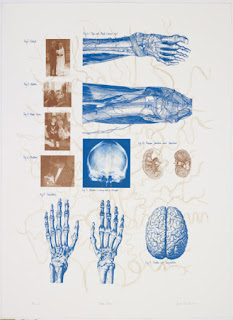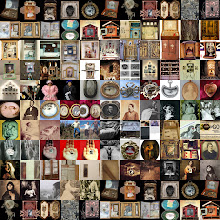Susan Aldworth's work is currently on show at the National Portrait Gallery, until the 1st of September 2013. I am interested in her work because she works primarily with printmaking processes, the 3 pieces on show being portraits consisting of 9 monotypes; and with medical imagery, in this case with historical and modern scans of the human body. The sitters are people with epilepsy, a condition that links with the artists' search for ways to visualise the self. She has worked before with people with Alzheimer and Schizophrenia, and her current practice focuses on the gap between the physical materiality of the brain, and the interior sense of subjectivity.
My favourite piece is Elizabeth, 2012, whom Susan portrayed with an image of her face located in her lower abdomen, due to the woman's deep concerns about having a baby. A very interesting move, changing the commonly accepted seat of identity from the brain to the uterus. Elizabeth refused to take the drugs that controlled her epileptic attacks due to their impact on pregnancy, and with this risked her life. One could say thus, that her strong yearning for being a mother is effectively reflected in the portrait, where her face, her identity, lies within her womb.
I attended In Conversation: The Portrait Anatomised, on the 6th of June 2013, where a neuropsychologist, the artist, and Max (one of the sitters) came together. Most of the conversation turned around the difficulties of grasping the self, and the gap between the physical brain and consciousness. Susan's use of medical imagery is a turn in comparison to the tradition of portraiture hosted at the gallery, medicine portrays the inside in a literal and 'truthful' way. Furthermore, medical imaging captures a fragment and perhaps depicts a more suiting vision of a changing, fractured and elusive self? In comparison to traditional portraiture that seems to idealise subjectivity, elevating it to the status of 'essence', immutable and immortalized in the process of representation, almost assuming the existence of the soul.
I described medical images as 'truthful' because I think this notion of verisimilitude is problematic, the self is something we have a sense of, but that by definition cannot be seen, therefore what we see in medical images is not it, but it's as close as we can get to having a visual token of what it's like, where it inhabits. Following scientific discourse, we are not used to believing in things that we cannot see, we deem they do not exist, thinking that the other alternative, the soul, lies in the realm of religion. However, just because science cannot provide us an image of it, it does not mean the self does not exist, and it does not mean it is necessarily the soul.
We exist in the minds of others that know us (who know more of, or differently, about us than we do), and our unconscious also exists, the even more elusive version of our subjectivity. We are too used to equating seeing with believing, to equating what we think with what we are, and to looking for the truth by removing the skin, as if it stood for the fake appearance concealing the ultimate reality. We learned the story of the Incredulity of St Thomas all too well, and forgot it was a story.
The Incredulity of St Thomas, Caravaggio.
These are two lithographs from 2012 by Susan Aldworth, were she explores anatomically unorthodox representations of the body:
Nature Nurture 2
Reassembling the Self 4







